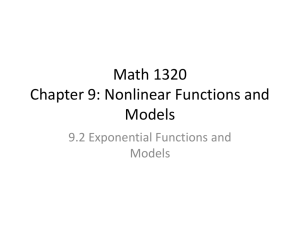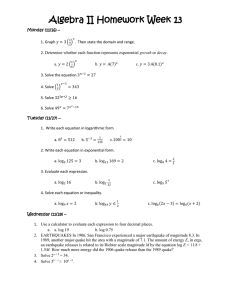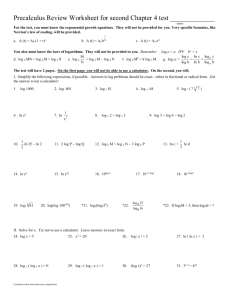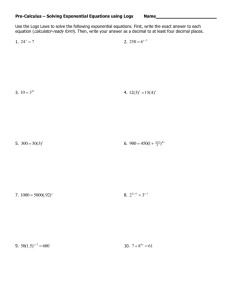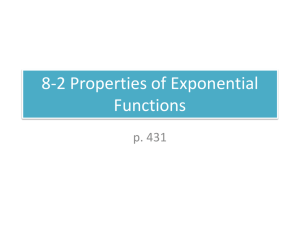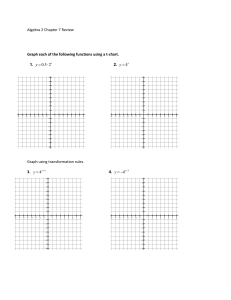1.3 & 1.5: Exponential and Logarithmic Functions A has the form
advertisement
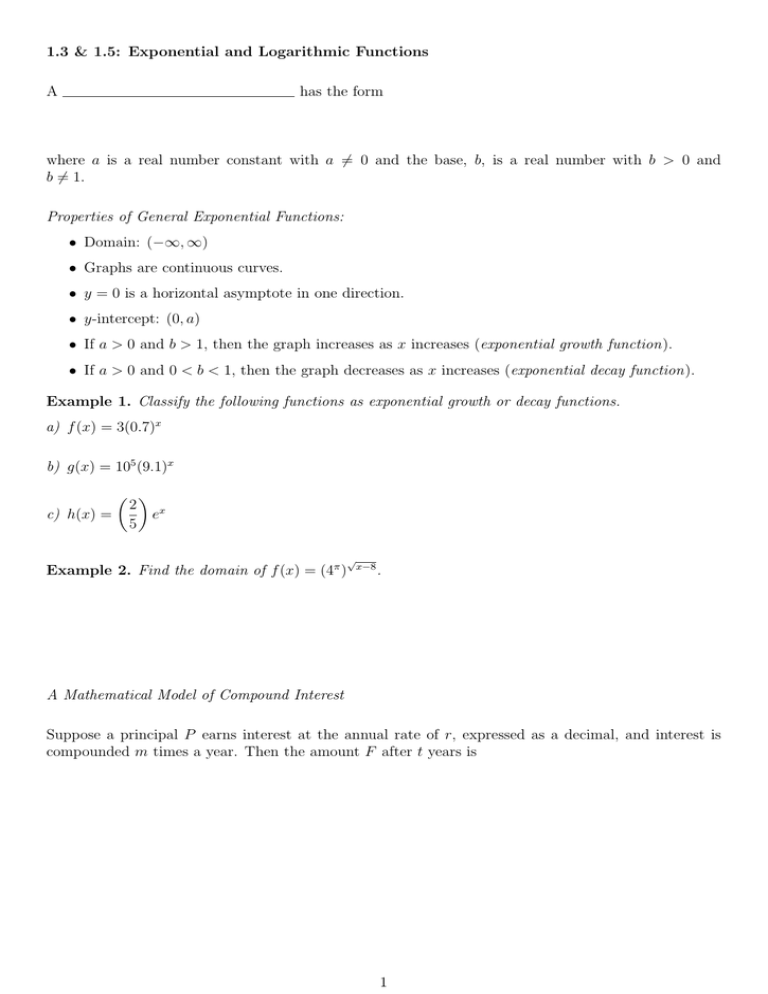
1.3 & 1.5: Exponential and Logarithmic Functions A has the form where a is a real number constant with a 6= 0 and the base, b, is a real number with b > 0 and b 6= 1. Properties of General Exponential Functions: • Domain: (−∞, ∞) • Graphs are continuous curves. • y = 0 is a horizontal asymptote in one direction. • y-intercept: (0, a) • If a > 0 and b > 1, then the graph increases as x increases (exponential growth function). • If a > 0 and 0 < b < 1, then the graph decreases as x increases (exponential decay function). Example 1. Classify the following functions as exponential growth or decay functions. a) f (x) = 3(0.7)x b) g(x) = 105 (9.1)x 2 x c) h(x) = e 5 √ Example 2. Find the domain of f (x) = (4π ) x−8 . A Mathematical Model of Compound Interest Suppose a principal P earns interest at the annual rate of r, expressed as a decimal, and interest is compounded m times a year. Then the amount F after t years is 1 WE WILL USE TVM SOLVER! (We cannot use TVM Solver for simple interest calculations, only compound interest.) Compound Interest with TVM Solver on the Calculator: 1. Press APPS. 2. Select Finance... (Option 1) 3. Select TVM Solver (Option 1) • N = total number of compoundings during the time period • I% = interest rate (as a percent) • P V = initial amount in the account • P M T = regularly occuring payments • F V = future value of the account • P/Y = C/Y = the number of payments/compoundings per year • END/BEGIN (Note: END should be higlighted) 4. Enter the known information. 5. Scroll to the line representing the unknown data. 6. Press SOLVE (ALPHA → ENTER) Important Note: In the TVM Solver, the values for PV, PMT, and FV will sometimes be negative. This is done to represent the transfer or flow of money. We will usually look at these problems from the standpoint of the investor or borrower. A negative number represents an of money away from the investor or borrower, i.e., when money is leaving your pocket. Use a negative number when: • Making payments • Depositing money in a bank A positive number represents an of money to the investor or borrower, i.e., when you put money in your pocket. Use a positive number when: • You receive a loan from a bank or lender. • You receive money from a bank account. 2 Example 3. How much is in an account after 37 years if $14,000 was initially deposited into an account earning 7.8% per year compounded a) annually b) quarterly c) monthly d) weekly e) daily Example 4. The United States paid about 4 cents per acre for the Louisiana Purchase in 1803. Suppose the value of this property grew at an annual rate of 6% per year compounded annually. What would an acre be worth in 2015? 3 Suppose a sum of money is invested at an annual rate of r expressed as a decimal and is compounded m times a year. The effective yield ref f is Effective Yield with Your Calculator: 1. Press APPS. 2. Select Finance... (Option 1) 3. Select .Eff (Option C) 4. Give the arguments as follows: Eff(r,m). (r here is as a percent) Example 5. One bank advertises a nominal rate of 8.25% per year compounded semiannually. A second bank advertises a nominal rate of 8.16% per year compounded weekly. What are the effective yields rounded to four decimal places? In which bank would you deposit your money? Example 6. Find the present value of an account so that the account has $15,000 in it after 17 years if the account earns interest at the rate of 9% per year compounded a) quarterly b) monthly c) weekly 4 Example 7. A person has $1500 and can invest it in an account that earns an annual rate of 10% compounded quarterly. How long will it take for the account to double? Round to two decimal places. Example 8. Reconsider the account in Example 1. How much is in the account if we compounded a) hourly? b) by the minute? Thus, as the number of compoundings per year increases, the amount in the account increases, but seems to be limited by some finite amount. This amount is the amount of the account if we were to compound interest continuously. The number e: It can be shown that as n gets larger and larger, (1 + n1 )n approaches the value 2.718281828... = e. The exponential function with base e has the form f (x) = aebx where a and b are real number constants. Properties of Exponential Function with Base e: If a > 0 and b 6= 0, • Domain: (−∞, ∞) • Range: (0, ∞) • y-intercept: (0, a) • If b > 0, then it is an exponential growth function. • If b < 0, then it is an exponential decay function. 5 We can use the base e to find continuously compounded interest. If a principal P earns interest at the annual rate of r expressed as a decimal, and interest is compounded continuously, then the amount F after t years is Example 9. How much is in an account after 30 years if $1,500 was initially deposited into an account earning 8.5% per year compounded continuously. Effective Yield for Continuous Compounding: Population Growth and Exponential Decay: Example 10. The human population of the world was about 6 billion in the year 2000 and increasing at the rate of 1.3% per year. Assuming that the population continued to grow exponentially (continuously) at this annual rate, find the population of the world in 2020 rounded to one decimal place. Similarly, if a population (or substance) decreases exponentially over time, then it can be modeled by an exponential decay model. 6 Properties of Exponentials: 1. ax · ay = 2. ax = ay 3. (ax )y = 4. a0 = 5. If a 6= 0, a−x = 6. am/n = 7. (ab)n = 8. a n b = 9. If a > 1, the function ax is increasing and concave up. 10. If 0 < a < 1, the function ax is decreasing and concave up. 11. If a 6= 1, then ax = ay if and only if x = y. 12. If 0 < a < 1, then the graph of y = ax approaches the x-axis as x becomes large. 13. If a > 1, then the graph of y = ax approaches the x-axis as x becomes negatively large. 7 Example 11. Simplify (x9 y 7 z 2 )2 . (y 5 z 4 )3 Example 12. Solve the following equations for x. a) 9x = 1 2 b) 252x = 5(−4x+1) c) 33x = 1 3−x+14 d) x10x = 10x Logarithms Let a be a positive number with a 6= 1. If x > 0, the loga x, is defined as follows: Example 13. Solve for x: 9 log4 x = 3 8 , denoted by Properites of Logarithms: 1. aloga x = 2. loga ax = 3. loga xy = 4. loga x = y 5. loga xc = 1 Example 14. Simplify 11 4 log11 16 . Example 15. Write the given quantity in terms of log x, log y, and log z. x5 y 4 log √ 5 ( z) Example 16. Write the given quantity as one logarithm. √ 5 log7 x − log7 y 9 Example 17. Solve for x. a) 8(176x ) = 34 √ b) 12 x = 24 c) log (5x) = log 25 The Natural Logarithm: If x > 0, the , denoted by ln x, is defined as follows: Example 18. The human population of the world was about 6 billion in the year 2000 and increasing at the rate of 1.3% per year. Assuming that the population continued to grow exponentially (continuously) at this annual rate, determine the year in which the population of the world will reach 7.5 billion. 10 We can write any exponential function in terms of the base e and any logarithmic function in terms of the natural logarithm. Let a > 0. Then ax = . loga x = BIG IDEA: Every exponential and logarithmic function can be written in terms of the base e and the natural logarithm. Example 19. A bacteria culture starts with 15000 bacteria, and after 2 hours the population is 25000 bacteria. Assuming that the culture grows exponentially, find the population after 5 hours. Example 20. After 3 days, a sample of radon-222 decayed to 60% of its original amount. a) What is the half-life of radon-222? Round to three decimal places. b) How long would it take the sample to decay to 20% of its original amount? Round to three decimal places. 11
